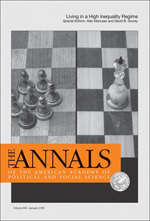
The ANNALS of the American Academy of Political and Social Science
Living in a High Inequality Regime
- David Grusky - Stanford University
- Alair MacLean - Washington State University Vancouver, USA, Washington State University Vancouver
Income inequality in the United States is the highest it has been since the roaring 20s. The rich are getting richer. The middle class is descending from the middle. The poor are getting poorer. What accounts for the increase in wealth at the top? What dynamic forces have shaped this spectacular disparity? How are Americans adjusting to life in this brave new world? What effect does the social fallout of this inequality regime have on the fabric of American society?
The effects of rising inequality have proven difficult to tease out, but as the United States enters a moment in history in which key policy decisions about inequality, mobility, and poverty are being made, it is important for researchers to examine this trend to learn why there is so much inequality in the United States. In this volume of The ANNALS experts examine the “social fallout” from this income imbalance. They shine a light on the winners and losers, focusing on occupational inequality, racial and gender inequality, as well as inequality in veteran groups. They explore accessibility and segregation to gauge how educational and crime/punishment trends are shaped by inequality. Finally, they examine how inequality impacts Americans’ views of themselves and others; the dynamics of class and culture; and the effects of socioeconomics on marriage, health, and death.